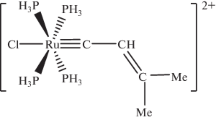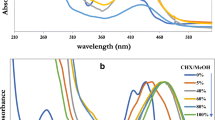Abstract
Two important aspects of the photophysics of dimethoxy curcumin in solvents are theoretically analysed. First, the large Stokes shift in cyclohexane and in acetonitrile is calculated using time-dependent density functional theory with large basis set. Second, a possible explanation is given for the considerable decrease of the nonradiative decay rate in changing from the nonpolar cyclohexane to polar acetonitrile. The solvent is treated using the polarizable continuum model. We analyse different isomers and obtain the absorption transition energies. Similarly, after obtaining the relaxed geometry of the excited state, the emission transition is obtained. In both cases, a red shift of the singlet transition is obtained with increasing solvent polarity. In contrast, the low-lying triplet states are essentially solvent independent. The calculated solvent shift in the emission is in very good agreement with experiment. The Stokes shifts are also in fair agreement with experiment when long-range or dispersion-corrected functionals are used. There are three calculated triplet states lying below the S 1 state. As they are π → π* states, they cannot participate in the intersystem crossing by the El-Sayed rule. However, a fourth triplet state of n → π* nature is found only slightly above the Franck–Condon position of the S 1 state, and the S 1 → T 4 separation increases with the solvent polarity, this being a possible explanation for the decrease of the nonradiative transition.





Similar content being viewed by others
References
Benzie I (2011) Herbal medicine: biomolecular and clinical aspects. CRC Press, Boca Raton
Sharma OP (1976) Antioxidant activity of curcumin and related compounds. Biochem Pharmacol 25:1811–1812. doi:10.1016/0006-2952(76)90421-4
Khopde M, Priyadarsini S, Venkatesan KI, Rao MNA P (1999) Free radical scavenging ability and antioxidant efficiency of curcumin and its substituted analogue. Biophys Chem 80:85–91. doi:10.1016/S0301-4622(99)00070-8
Banerjee A, Kunwar A, Mishra B, Priyadarsini KI (2008) Concentration dependent antioxidant/pro-oxidant activity of curcumin. Chem Biol Interact 174:134–139. doi:10.1016/j.cbi.2008.05.009
Sun Y-M, Zhang H-Y, Chen D-Z, Liu C-B (2002) Theoretical elucidation on the antioxidant mechanism of curcumin: a DFT Study. Org Lett 4:2909–2911. doi:10.1021/ol0262789
Chignell CF, Bilskj P, Reszka KJ et al (1994) Spectral and photochemical properties of curcumin. Photochem Photobiol 59:295–302. doi:10.1111/j.1751-1097.1994.tb05037.x
Goel A, Kunnumakkara AB, Aggarwal BB (2008) Curcumin as “Curecumin”: from kitchen to clinic. Biochem Pharmacol 75:787–809. doi:10.1016/j.bcp.2007.08.016
Balasubramanian K (2006) Molecular orbital basis for yellow curry spice curcumin’s prevention of Alzheimer’s disease. J Agric Food Chem 54:3512–3520. doi:10.1021/jf0603533
Hegge AB, Bruzell E, Kristensen S, Tønnesen HH (2012) Photoinactivation of Staphylococcus epidermidis biofilms and suspensions by the hydrophobic photosensitizer curcumin – Effect of selected nanocarrier: studies on curcumin and curcuminoides XLVII. Eur J Pharm Sci 47:65–74. doi:10.1016/j.ejps.2012.05.002
Ohtsu H, Xiao Z, Ishida J et al (2002) Antitumor agents. 217. curcumin analogues as novel androgen receptor antagonists with potential as anti-prostate cancer agents. J Med Chem 45:5037–5042. doi:10.1021/jm020200g
Lin L, Shi Q, Nyarko AK et al (2006) Antitumor agents. 250. Design and synthesis of new curcumin analogues as potential anti-prostate cancer agents. J Med Chem 49:3963–3972. doi:10.1021/jm051043z
Amolins MW, Peterson LB, Blagg BSJ (2009) Synthesis and evaluation of electron-rich curcumin analogues. Bioorg Med Chem 17:360–367. doi:10.1016/j.bmc.2008.10.057
Benassi R, Ferrari E, Lazzari S et al (2008) Theoretical study on Curcumin: a comparison of calculated spectroscopic properties with NMR, UV–vis and IR experimental data. J Mol Struct 892:168–176. doi:10.1016/j.molstruc.2008.05.024
Shen L, Ji H-F (2007) Theoretical study on physicochemical properties of curcumin. Spectrochim Acta A Mol Biomol Spectrosc 67:619–623. doi:10.1016/j.saa.2006.08.018
Bong P (2000) Spectral and photophysical behaviors of curcumin and curcuminoids. Bull Chem Soc 21:81–86
Khopde SM, Indira Priyadarsini K, Palit DK, Mukherjee T (2007) Effect of solvent on the excited-state photophysical properties of curcumin. Photochem Photobiol 72:625–631. doi:10.1562/0031-8655(2000)0720625
Haris P, Mary V, Aparna P et al (2017) A comprehensive approach to ascertain the binding mode of curcumin with DNA. Spectrochim Acta A Mol Biomol Spectrosc 175:155–163. doi:10.1016/j.saa.2016.11.049
Pérez E, Ibarra IA, Guzmán A, Lima E (2017) Hybrid pigments resulting from several guest dyes onto γ-alumina host: a spectroscopic analysis. Spectrochim Acta A Mol Biomol Spectrosc 172:174–181. doi:10.1016/j.saa.2016.04.017
Bonab MI, Sardroodi JJ, Ebrahimzadeh AR, Mehrnejad F (2017) A computational study of the electronic structure and the chemical activity of curcumin and some novel curcuminoids by density functional theory. J Iran Chem Soc 14:357–364. doi:10.1007/s13738-016-0984-x
Anjomshoa S, Namazian M, Noorbala MR (2016) The effect of solvent on tautomerism, acidity and radical stability of curcumin and its derivatives based on thermodynamic quantities. J Solut Chem 45:1021–1030. doi:10.1007/s10953-016-0481-y
Margar SN, Rhyman L, Ramasami P, Sekar N (2016) Fluorescent difluoroboron-curcumin analogs: an investigation of the electronic structures and photophysical properties. Spectrochim Acta A Mol Biomol Spectrosc 152:241–251. doi:10.1016/j.saa.2015.07.064
Priyadarsini KI, Maity DK, Naik GH et al (2003) Role of phenolic O–H and methylene hydrogen on the free radical reactions and antioxidant activity of curcumin. Free Radic Biol Med 35:475–484. doi:10.1016/S0891-5849(03)00325-3
Barik A, Priyadarsini KI (2013) Solvent dependent photophysical properties of dimethoxy curcumin. Spectrochim Acta A Mol Biomol Spectrosc 105:267–272. doi:10.1016/j.saa.2012.12.036
Nardo L, Andreoni A, Bondani M et al (2012) Studies on curcumin and curcuminoids. XLVI. Photophysical properties of dimethoxycurcumin and bis-dehydroxycurcumin. J Fluoresc 22:597–608. doi:10.1007/s10895-011-0995-z
Jasim F, Ali F (1992) A novel and rapid method for the spectrofluorometric determination of curcumin in curcumin spices and flavors. Microchem J 214:209–214
Rocha WR, Martins VM, Coutinho K, Canuto S (2002) Solvent effects on the electronic absorption spectrum of formamide studied by a sequential Monte Carlo/quantum mechanical approach. Theor Chem Acc 108:31–37. doi:10.1007/s00214-002-0353-y
Coutinho K, Canuto S (2000) Solvent effects in emission spectroscopy: a Monte Carlo quantum mechanics study of the n ← π∗ shift of formaldehyde in water. J Chem Phys 113:9132. doi:10.1063/1.1320827
Georg HC, Coutinho K, Canuto S (2005) A sequential Monte Carlo quantum mechanics study of the hydrogen-bond interaction and the solvatochromic shift of the n-π* transition of acrolein in water. J Chem Phys 123:1–8. doi:10.1063/1.2033750
Kirkwood JG (1934) Theory of solutions of molecules containing widely separated charges with special application to zwitterions. J Chem Phys 2:351. doi:10.1063/1.1749489
Onsager L (1936) Electric moments of molecules in liquids. J Am Chem Soc 58:1486–1493
Tapia O, Goscinski O (1975) Self-consistent reaction field theory of solvent effects. Mol Phys 29:1653–1661. doi:10.1080/00268977500101461
Tomasi J, Mennucci B, Cammi R (2005) Quantum mechanical continuum solvation models. Chem Rev 105:2999–3094. doi:10.1021/cr9904009
Becke AD (1993) A new mixing of Hartree–Fock and local density-functional theories. J Chem Phys 98:1372. doi:10.1063/1.464304
Lee C, Yang W, Parr RG (1988) Development of the Colle-Salvetti correlation-energy formula into a functional of the electron density. Phys Rev B 37:785–789. doi:10.1103/PhysRevB.37.785
Marques MAL, Gross EKU (2004) Time-dependent density functional theory. Annu Rev Phys Chem 55:427–455. doi:10.1146/annurev.physchem.55.091602.094449
Adamo C, Barone V (1999) Toward reliable density functional methods without adjustable parameters: the PBE0 model. J Chem Phys 110:6158. doi:10.1063/1.478522
Yanai T, Tew DP, Handy NC (2004) A new hybrid exchange-correlation functional using the Coulomb-attenuating method (CAM-B3LYP). Chem Phys Lett 393:51–57. doi:10.1016/j.cplett.2004.06.011
Da Chai J, Head-Gordon M (2008) Long-range corrected hybrid density functionals with damped atom-atom dispersion corrections. Phys Chem Chem Phys 10:6615–6620. doi:10.1039/b810189b
Da Chai J, Head-Gordon M (2008) Systematic optimization of long-range corrected hybrid density functionals. J Chem Phys 128:88106. doi:10.1063/1.2834918
Caricato M, Mennucci B, Tomasi J et al (2006) Formation and relaxation of excited states in solution: a new time dependent polarizable continuum model based on time dependent density functional theory. J Chem Phys 124:124520. doi:10.1063/1.2183309
Scalmani G, Frisch MJ, Mennucci B et al (2006) Geometries and properties of excited states in the gas phase and in solution: theory and application of a time-dependent density functional theory polarizable continuum model. J Chem Phys 124:94107. doi:10.1063/1.2173258
Frisch MJ, Trucks GW, Schlegel HB, et al (2009) Gaussian09
Galer P, Golobič A, Koller J et al (2013) Structures in solid state and solution of dimethoxy curcuminoids: regioselective bromination and chlorination. Chem Cent J 7:107. doi:10.1186/1752-153X-7-107
Kong X, Brinkmann A, Terskikh V et al (2016) Proton probability distribution in the O···H···O low-barrier hydrogen bond: a combined solid-state NMR and quantum chemical computational study of dibenzoylmethane and curcumin. J Phys Chem B 120:11692–11704. doi:10.1021/acs.jpcb.6b08091
Santin LG, Toledo EM, Carvalho-Silva VH et al (2016) Methanol solvation effect on the proton rearrangement of curcumin’s enol forms: an Ab initio molecular dynamics and electronic structure viewpoint. J Phys Chem C 120:19923–19931. doi:10.1021/acs.jpcc.6b02393
da Cunha AR, Duarte EL, Lamy MT, Coutinho K (2014) Protonation/deprotonation process of Emodin in aqueous solution and pKa determination: uV/Visible spectrophotometric titration and quantum/molecular mechanics calculations. Chem Phys 440:69–79. doi:10.1016/j.chemphys.2014.06.009
Shen L, Ji H-F, Zhang H-Y (2005) A TD-DFT study on triplet excited-state properties of curcumin and its implications in elucidating the photosensitizing mechanisms of the pigment. Chem Phys Lett 409:300–303. doi:10.1016/j.cplett.2005.05.023
Acknowledgements
We thank Dr. Y. Orozco-Gonzales and Dr. Marcelo H. Cardenuto for discussions. This work is partially supported by grant 2013/01,871-5 from São Paulo Research Foundation (FAPESP), CNPq, CAPES and INCT-FCx.
Author information
Authors and Affiliations
Corresponding author
Rights and permissions
About this article
Cite this article
Ramos, T.N., Canuto, S. A theoretical study of the low-lying excited states and the photophysics of dimethoxy curcumin in cyclohexane and acetonitrile. Theor Chem Acc 136, 78 (2017). https://doi.org/10.1007/s00214-017-2108-9
Received:
Accepted:
Published:
DOI: https://doi.org/10.1007/s00214-017-2108-9




